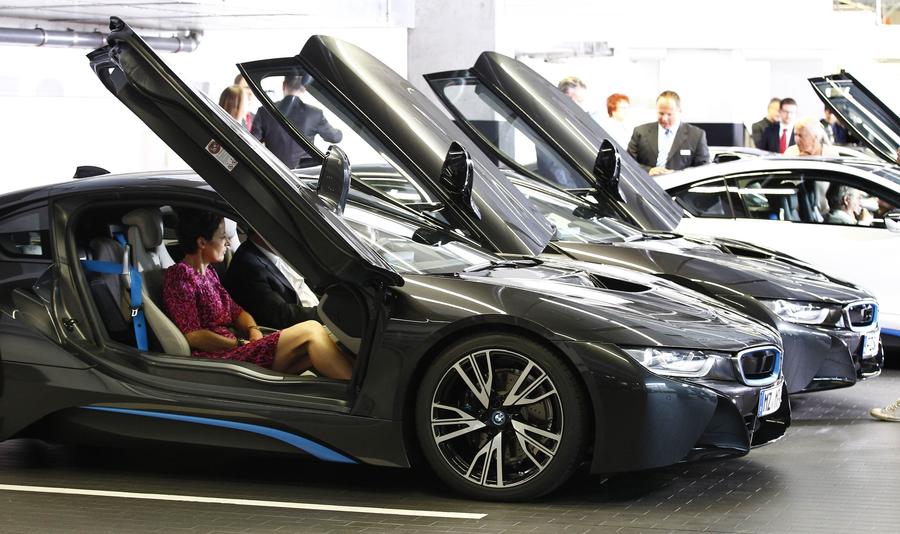


Not me, I want the i8.
Posted on 01/10/2015 9:32:02 AM PST by LogicDesigner
Plug-in electric car sales for calendar year 2014 rose above the 100,000 level, the third annual increase in full-year sales in the U.S. since modern electric cars first went on sale in December 2010.
The highest-selling electric car in the world, the Nissan Leaf, set a new U.S. record for plug-in sales of a single vehicle in one year, logging 30,200 deliveries during 2014.
That compares to a 2013 total of 22,610, and less than 10,000 units in each of its first two years on sale.
The balance of 70,000-plus was made up of sales of no fewer than 20 other cars with plugs.
(We also note that Hyundai leased 54 of its hydrogen-powered Tucson Fuel Cell crossover utility vehicles. Honda delivered 2 FCX Clarity fuel-cell vehicles as well this year, against 10 leased in 2013.)
The bulk of them, however, remain quite low-volume, selling 250 or fewer units per month.
Only a small number of plug-in electric cars routinely racks up U.S. sales of 1,000 or more units a month.
The others include the Chevrolet Volt and the Tesla Model S. More recently, the BMW i3 sales hit that level for three months last year.
(Excerpt) Read more at greencarreports.com ...
How much did the American taxpayer shell out so these eco clowns can pretend they’re helping Al Gore defeat the evil sun?
What’s green about using household electricity to power a car?
How much are they paying to upkeep the roads and highways since they don’t pay gas tax?
Hybrids like the Toyota Prius have been successful and well-received.
Electric cars on the other hand, occupy a niche market. Tesla Motors is a toy for the well to do.
It’ll be a long time before the electric car has potential to appeal to mass market car buyers.
I saw a Tesla in front of me the other day and it looked nice.
I have no idea about it though. How much it costs. How far it goes on a charge. How long it takes to charge etc...
With the current cold weather, many electric cat owners are finding out they cannot even commute to the office because their range has been more than cut in half.
A roadster costs around a few hundred thousand dollars. It a well built, high quality car with a fit and finish equivalent to those found on a luxury German sedan.
With a smart charger upgrade, a Tesla S can now be recharged in an hour.
It can go 300 miles on a charge but real world driving conditions mean its likely to be lower than the advertised driving range.
That said, people who own one love it.
The top end Tesla Model S gets 267 miles of EPA rated range. That means that if the weather is mild and you are easy on the accelerator, you can expect around 300 miles and if the weather is sub-freezing and you have the heater turned up you can expect around 200 miles.
I see them everywhere /s
These are just very fancy golf carts and an indulgence for the wealthy. They are not a working person’s vehicle.
Once we perfect the fuel cell for wide and economical manufacture, and get the hydrogen mines in full production, the electrically powered car shall stand a decent chance of wide acceptance. But until then, battery power supply shall not be a sufficiently reliable means of energy storage. Certainly not as economical as hydrocarbon fuel.
You are talking the Luxury Car of all EVs. Accelerates comparable to a performance sports car. I am not so sure about the charge time, but yes, it’s a powerful sucker that puts many regular gas-powered cars to shame in terms of how it drives, despite taking some time to charge up.
What may be a lot more viable are plug-in hybrids with better battery designs that could push the all-electric range of the vehicle to 40-60 miles before the gasoline engine "kicks in" to provide power and to recharge the battery.
I would call that an understatement. With a 0 to 60 mph time of 3.2 seconds, the Model S P85D is the fastest accelerating four-door production car in the world.
A Toyota Prius already does that - in town, you can run the car on the electric battery; when you’re on the open highway, the gas engine kicks in to provide extended driving range and recharge the battery during the drive.
Yea, that's why I tell people who raise concerns about the range to look at the Chevy Volt: your first 40 miles every day are electric follow by 340 miles of gas tank if you need to go farther.
The problem is the long recharge cycle. Range is irrelevant.
I hear the power plants are burning gas now that the prices have dropped so much. It’s just a shell game, the ‘lectric cars are just using petroleum in a less efficient manner.



Not me, I want the i8.
Disclaimer: Opinions posted on Free Republic are those of the individual posters and do not necessarily represent the opinion of Free Republic or its management. All materials posted herein are protected by copyright law and the exemption for fair use of copyrighted works.